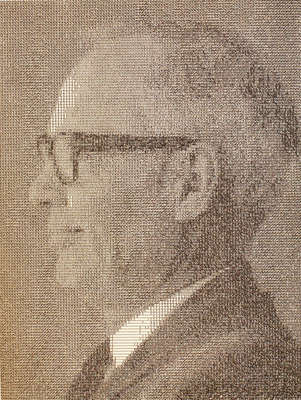Created by w.H.Allner in collaboration with H. Philip Peterson from Control Data Corporation Digigraphics Laboratories in Burlington (Mass.).lt shows a portrait of the president of the company at that time, William Charles Norris. It was the first computer generated portrait to be published, illustrating an article about the Control Data Corporation in the February edition of Fortune in 1968. The first cover of the magazine to be designed with the aid of a computer was that of the July edition in 1965.
To facilitate its production, the programmers of MIT in Cambridge (Mass.) had developed a programme tailored to Allner’s ideas. This image was generated using Picture Processing – a pictorial composition per micro-signs that permitted a superordinate figure to be recognised while nonetheless appearing to dissolve in detail:
“The picture, on close examination, is seen to be made up of numbers from 00 (represented by blanks) to 99, each higher number slightly blacker than its predecessor […]. To archive this result, one of the computer’s input devices scanned a normal photograph of Mr. Norris electronically, converting light and shade into elec- trical values. The machine, appropriately programmed by Mr. Peterson, then reconverted the voltages into pen movements, into drawing numbers of a value, weight and position to corre- spond to the original photograph. The result was converted by photoengraving into a line cut for publication in Fortune.” (Letter from Fortune dated 30th January 1968, Archive ofthe Kunsthalle Bremen) 5This was also the method by which Peterson produced his well-known works Mona Lisa, which was used for the cover of the magazine Computers and Automation 1965 and digital Norbert Wiener.


